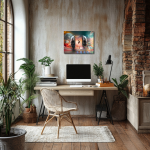Transcending Realities: Reflections by the Bridge at Vervy
This conceptual expressionist reinterpretation of Monet’s The Grande Creuse by the Bridge at Vervy (1889) merges the artist’s vibrant landscape with surreal, futuristic elements to depict the profound intersection of reality, imagination, and introspection. Amidst softly blurred forms and iridescent colors, a solitary figure sits thoughtfully, embodying humanity’s quiet yet powerful journey inward. The scene explores the fluidity of perception, suggesting that our inner worlds—rich with dreams and memories—shape and transform the reality we see. This work eloquently conveys the tension between tangible beauty and intangible imagination, celebrating the transcendent power of human reflection.
Please see Below for Details…
Hotline Order:
Mon - Fri: 07AM - 06PM
404-872-4663
Claude Monet’s The Grande Creuse by the Bridge at Vervy (1889) surpasses mere documentation of landscape and ventures into an intimate, thoughtful exploration of perception’s delicate fabric and its ability to reshape reality through the subtle interplay of color, light, and form. Monet was not content simply to depict landscapes as static scenes. Rather, he infused his canvases with a vitality and impermanence reflective of the fleeting effects of sunlight and atmosphere, emphasizing the transitory nature of the world through quick, rhythmic brushstrokes and layered harmonies of color.
This conceptual reinterpretation expands Monet's intimate dialogue with light into a broader meditation on human consciousness, imagination, and the perpetual interplay between the tangible and the intangible. Here, the landscape of The Grande Creuse by the Bridge at Vervy (1889) is transformed into a surreal narrative, suspended between reality, memory, and the boundless possibilities of the imagination. The familiar contours of Monet’s original landscape, vibrant and expressive, gently dissolve into a fantastical environment, blending seamlessly with futuristic, ethereal elements that invite contemplation on the coexistence of past and future, tradition and innovation.
In the foreground, gentle pastel-hued cottages and idyllic countryside features softly emerge, still recognizable from Monet’s initial portrayal yet now subtly dreamlike, shimmering with an otherworldly luminosity. They appear delicate, almost spectral, their colors softly refracting through a veil of mystical, iridescent hues. Monet’s signature palette of radiant purples, blues, and greens creates a serene yet profound sensation of tranquility and nostalgia. The buildings, nestled quietly beneath hillsides, seem suspended not only in time but also in a gentle mist of memories, floating delicately between clarity and abstraction.
Dominating the composition’s center is an intriguing juxtaposition—a striking arrangement of futuristic, sleek pods occupied by solitary human figures. These figures, encased within transparent capsules, sit quietly, introspective and absorbed in contemplation, their postures conveying a deep, thoughtful isolation. Between them, a solitary man is seated upon a simple stool, bathed in warm, golden light, absorbed in thought. He appears suspended in the midst of both past and future, his surroundings dissolving into a surreal, dream-like expanse. This central figure symbolizes human introspection, the profound journey inward, the quiet yet powerful pursuit of understanding, imagination, and reflection.
Surrounding these figures, the landscape transforms into a series of gently layered realities, shifting fluidly between Monet’s original vision and an imaginary, cosmic dreamscape. At the edges, futuristic capsules—sleek, metallic, and reflective—hover quietly, occupied by solemn figures who face opposite directions, gazing silently into unseen vistas. These elements, surreal and enigmatic, evoke the idea of contemplation, meditation, and the infinite potentials of human imagination. The juxtaposition of Monet’s richly textured landscape with these futuristic forms emphasizes the tension between the tangible world and our inner, intangible realms, underscoring how the power of perception can seamlessly bridge worlds that seem separated by time and space.
Surrounding the figures, the environment transforms gently, merging Monet’s soft brushwork with dream-like celestial vistas—otherworldly planets float quietly in distant skies, illuminated by ethereal light. These planets and landscapes hover gracefully, symbolizing the endless horizons of human thought and creativity. They represent the vast inner landscapes of the human mind, worlds we create and traverse through memory, dreams, and imagination, places that exist only because we perceive them, yearn for them, and believe in them.
The composition as a whole creates a delicate balance between Monet’s original expressive landscape and a broader exploration of the boundless potential of human imagination. It portrays perception as a dynamic, transformative force that continuously redefines reality, shaping the ordinary world into something extraordinary, mystical, and deeply meaningful. The central figure represents all of us, caught in contemplation, caught between the certainties of the past and the uncertainties of future possibilities. His presence, calm and reflective, anchors the piece emotionally, reminding viewers of the quiet power within moments of solitude and reflection.
In creating this piece, I sought to echo Monet’s fascination with capturing the transient beauty of the natural world and to extend it into a conceptual exploration of human introspection and imagination. Monet’s work is not simply about painting landscapes; it is about seeing deeply, feeling profoundly, and expressing the fleeting, elusive qualities of perception itself. By integrating futuristic elements, I wanted to highlight how perception bridges realities, linking tangible places to imagined possibilities, revealing how our inner worlds profoundly influence our external realities.
This artwork is an invitation to reflect on the delicate, beautiful tension between reality and imagination. It is about understanding that landscapes—like our thoughts, dreams, and memories—are fluid and transformative, constantly shaped by our perceptions. Monet’s landscape, merging gently with surreal and abstract forms, symbolizes humanity’s perpetual quest to transcend the mundane, to see beyond the immediate, and to find meaning in the subtle beauty of shifting perception itself.
Add your review
Your email address will not be published. Required fields are marked *
Please login to write review!
Looks like there are no reviews yet.








